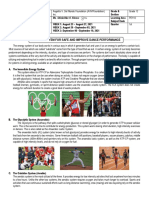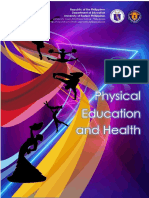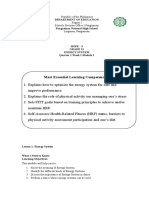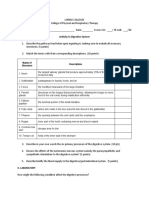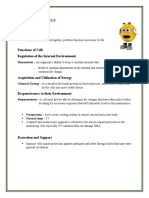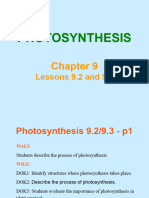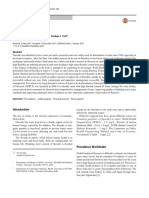Week 1 2
Week 1 2
Uploaded by
Aliyah M.Copyright:
Available Formats
Week 1 2
Week 1 2
Uploaded by
Aliyah M.Original Title
Copyright
Available Formats
Share this document
Did you find this document useful?
Is this content inappropriate?
Copyright:
Available Formats
Week 1 2
Week 1 2
Uploaded by
Aliyah M.Copyright:
Available Formats
Apostolic Vicariate of Calapan Parochial Schools
MINA DE ORO CATHOLIC SCHOOL, INC.
St. Bernard Peters St. Zone 3, Socorro, Oriental Mindoro
_______________________________________________________________________________________________________________________________________
Physical Education and Health 3
What is PEH 3?
Physical Education and Health offers experiential learning for learners to adopt an active life for fitness and lifelong
health. The knowledge, skills and understanding which include physical and health literacy competencies support
them in accessing, synthesizing and evaluating information; making informed decisions; enhancing and advocating their
own as well as others’ fitness and health.
This course on dance includes rhythmical movement patterns; the promotion and appreciation of Philippine
folk dance, indigenous and traditional dances as well as other dance forms. It consists of an array of offerings which
learners can choose from.
The learner demonstrates understanding of dance in optimizing one’s health; as
Content Standard: requisite for physical activity assessment performance, and as a career opportunity.
The learner leads dance events with proficiency and confidence resulting in
Performance Standard: independent pursuit and in influencing others positively
Most-Essential Learning Self-assesses health-related fitness (HRF). status, barriers to physical activity
Competencies: assessment participation and one’s diet
Time Frame 1 hour
My Targets:
Explains how to optimize the energy systems for safe and improved
performance
Identify the different kindd if Energy Systems
Discuss the importance of Energy Systems in dance.
Quarter 1 I week 1
LECTURE
A. The Immediate Energy System
This system refers to ATP-CP or Adenosine Triphosphate-Creatine Phosphate. It is called the immediate
energy system where it is the first system that can be use when doing an activity. It does not require oxygen
(anaerobic) and it does not produce lactate (as with glycolysis). Instead, the system involves ATP and
Creatine Phosphate that are stored within the muscle fibers. Athletes who compete in sports that require
high amounts of short duration acceleration—shot-putters, weightlifters, American football linemen,
gymnasts, or sprint-distance speed skaters use the anaerobic a-lactic system. The ALA system does not
create energy for sufficient duration to create a great deal of waste products
B. The Glycolytic System (Anaerobic)
The Glycolysis is the pathway that splits carbohydrate (glucose or stored glycogen) in order to generate ATP
to power cellular work. This is the second in line to contribute for energy production. This system works
1 | P a g e Prepared by: DIWATA B. LAYRON, LPT
Apostolic Vicariate of Calapan Parochial Schools Physical Education and Health 12
MINA DE ORO CATHOLIC SCHOOL, INC. 0950-772-0557 diwata_layron@yahoo.com
SENIOR HIGH SCHOOL DEPARTMENT
during short-duration, high intensity exercises or dances. This is also called as the Anaerobic Lactic
System. The anaerobic lactic (AL) system (also known as fast glycolysis) provides energy for medium to
high intensity bursts of activity that lasts from ten seconds to two minutes. Some American football skill
positions, baseball players, soccer players, judokas, middle distance runners (400m-800m) and sprinters
rely on this system. The anaerobic lactic system, as well as the ATP-CP system, are capable of high
intensity levels, and do not rely on oxygen for fuel.
C. The Oxidative System (Aerobic)
The aerobic system is the most utilized of the three. It provides energy for low intensity activities that last
anywhere from two minutes to a few hours. Unlike the other two systems, the aerobic system requires
oxygen and takes much longer to overload. Sports and activities that use continuous sustained efforts such
as long-distance swimming, crew (rowing) and sea kayaking rely on the aerobic system.
BRIEF INTRODUCTION
The energy system of our body works in different ways in which it generates fuel and uses it as an energy to
perform a certain task. We all know that in able for our body to work, all we must do is to eat. The food that
we eat gives as the energy to do work and to accomplish something. These food serves as the fuel of our
body. A certain energy system of our body becomes predominant depending on the intensity, duration, and
type of exercises we perform.
Energy systems in our body includes the ATP-CP System, Glycolysis, and Oxidative. In the previous grade
level, these energy systems were discussed in the concept of exercise and sports. In this module, you will
learn how energy systems functions in the concept of dance.
Energy Systems in the Body
The human body uses energy from food to fuel movement and essential body functions, but the body cells
don't get energy directly from food. After food is digested, the carbohydrates, protein and fat break down
into simple compounds -- glucose, amino acids and fatty acids -- which are absorbed into the blood and
transported to various cells throughout the body. Within these cells, and from these energy
sources, adenosine triphosphate (ATP) is formed to provide fuel. The body uses 3 different systems to
supply cells with the necessary ATP to fuel energy needs. Most of the body's activities use a continuum of all
three energy systems, working together to ensure a constant supply of energy.
ATP-PC System
The body needs a continuous supply of ATP for energy -- whether the energy is needed for lifting weights,
walking, thinking or even texting. It's also the unit of energy that fuels metabolism, or the biochemical
reactions that support and maintain life. For short and intense movement lasting less than 10 seconds, the
body mainly uses the ATP-PC, or creatine phosphate system. This system is anaerobic, which means it
does not use oxygen. The ATP-PC system utilizes the relatively small amount of ATP already stored in the
muscle for this immediate energy source. When the body's supply of ATP is depleted, which occurs in a
matter of seconds, additional ATP is formed from the breakdown of phosphocreatine (PC) -- an energy
2 | P a g e Prepared by:DIWATA B. LAYRON, LPT
Apostolic Vicariate of Calapan Parochial Schools Physical Education and Health 12
MINA DE ORO CATHOLIC SCHOOL, INC. 0950-772-0557 diwata_layron@yahoo.com
SENIOR HIGH SCHOOL DEPARTMENT
compound found in muscle.
Lactic Acid System
The lactic acid system, also called the anaerobic glycolysis system, produces energy from muscle glycogen
-- the storage form of glucose. Glycolysis, or the breakdown of glycogen into glucose, can occur in the
presence or absence of oxygen. When inadequate oxygen is available, the series of reactions that transforms
glucose into ATP causes lactic acid to be produced -- in efforts to make more ATP. The lactic acid system
fuels relatively short periods -- a few minutes -- of high-intensity muscle activity, but the accumulation of
lactic acid can cause fatigue and a burning sensation in the muscles.
Aerobic System
The most complex energy system is the aerobic or oxygen energy system, which provides most of the
body's ATP. This system produces ATP as energy is released from the breakdown of nutrients such as
glucose and fatty acids. In the presence of oxygen, ATP can be formed through glycolysis. This system also
involves the Krebs or tricarboxylic acid cycle -- a series of chemical reactions that generate energy in the
mitochondria -- the power plant inside the body cells. The complexity of this system, along with the fact that
it relies heavily on the circulatory system to supply oxygen, makes it slower to act compared to the ATP-PC
or lactic acid systems. The aerobic system supplies energy for body movement lasting more than just a
few minutes, such as long periods of work or endurance activities. This system is also the pathway that
provides ATP to fuel most of the body's energy needs not related to physical activity, such as building and
repairing body tissues, digesting food, controlling body temperature and growing hair.
The Energy Used in Dancing by Cherrish Plummer
1. Production of Lactic Acid
• Lactic acid occurs when your body is working hard.
• When it is not working fast enough, lactate builds up in your muscles causes your
muscles to hurt.
2. Aerobic or Anaerobic
• The motion of dancing (Ballet) is aerobic
• This particular activity is aerobic because in most cases dancing is slow and rhythmical.
3. Storage
• The body stores ATP in muscle in the form of Glycogen.
• This storage is for needed energy for doing activities
4. Energy System
• The oxidative system is the primary source of ATP during aerobic activities
• Oxidative energy primarily uses carbohydrates and fats as substrates for energy.
5. Mitochondrial/Metabolic Rate
• Mitochondria are referred as the “powerhouse of the cell”
• They also contain a lot of the enzymes, associated with aerobic energy • The aerobic oxidative system forms
a big part of our bodies metabolic rate.
3 | P a g e Prepared by:DIWATA B. LAYRON, LPT
Apostolic Vicariate of Calapan Parochial Schools Physical Education and Health 12
MINA DE ORO CATHOLIC SCHOOL, INC. 0950-772-0557 diwata_layron@yahoo.com
SENIOR HIGH SCHOOL DEPARTMENT
ATTACHMENT #1
( S U B M I T T H I S P A G E / S O N L Y !)
Name:___________________________________________________ Date:________________
Grade & Section: Grade 12 - St._________________________ Score:_______________
Activity #1:
List down at least 5 activities that requires the following Energy Systems
ATP-CP GLYCOLYTIC OXIDATIVE
1. 1. 1.
2. 2. 2.
3. 3. 3.
4. 4. 4.
5. 5. 5.
How does the energy systems work in dance? (Explain)
_________________________________________________________________________________
_________________________________________________________________________________
_________________________________________________________________________________
_________________________________________________________________________________
_________________________________________________________________________________
_________________________________________________________________________________
_________________________________________________________________________________
_________________________________________________________________________________
Activity #2: (Mini Task)
1. Create a fitness workout program designed at home to keep your health
and immune system improved. Make at least 5 examples.
Example:
• Jumps and Jacks
• 16 counts
• 4 reps
• 3 sets
2. Execute the workout program you designed in 4-5 minutes. Send the
video online thru FB Messenger. The video is set in a time-lapse mode and can
be editted with an audio of your choice. Then answer the question in the box
below.
My Fitness Workout Program “Why do you need to perform flexibility
and strengthening exercises to
improve performance? Explain.”
4 | P a g e Prepared by:DIWATA B. LAYRON, LPT
Apostolic Vicariate of Calapan Parochial Schools Physical Education and Health 12
MINA DE ORO CATHOLIC SCHOOL, INC. 0950-772-0557 diwata_layron@yahoo.com
SENIOR HIGH SCHOOL DEPARTMENT
Quarter 1 I week 2
Physical Education and Health 3
The learner demonstrates understanding of dance in optimizing one’s health; as
Content Standard: requisite for physical activity assessment performance, and as a career opportunity.
The learner leads dance events with proficiency and confidence resulting in
Performance Standard: independent pursuit and in influencing others positively
Most-Essential Learning Sets FITT goals based on training principles to achieve and/or maintain
Competencies: HRF
Time Frame 1 hour
My Targets:
Know the meaning of FITT Principles
Identify the use of each principle
Discuss the importance of FITT Principles
Perform a task using the FITT Principles
LECTURE
3 Ways Dancing Relieves Stress
1. WHEN THE BODY FEELS GOOD, THE MIND DOES, TOO!
• The scientific reason for why dance has the ability to act as a stress reliever stems from the idea that when
the body feels good, the mind does, too.
• Any type of physical activity releases neurotransmitters and endorphins which serve to alleviate stress.
Neurotransmitters are chemicals within the brain that help communicate messages throughout the body.
• Endorphins are the body’s natural painkiller to reduce stress and improve
the mind’s perception of the world.
2. DANCE OFFERS A CREATIVE OUTLET FOR PEOPLE TOEXPRESS THEIR PERSONALITIES IN A
SAFEENVIRONMENT
• Dancing offers an outlet for people to express who they are––throughmusic, movement or even costumes!
• Dancing helps you connect to who you really are. Leave that suit orpencil skirt at the office and trade it in
for sparkles and spandex!
3. DANCING IMPROVES YOUR PHYSICAL HEALTH
• From weight loss, to increased flexibility, stronger bones and buildingmuscle tone, dancing is a total body
workout.
• Dancing can be a way to stay fit for people of all ages, shapes and sizes. It has a wide range of physical and
mental benefits
FITT PRINCIPLE
The FITT Principle (or formula) is a great way of monitoring your exercise program. The acronym FITT
outlines the key components, or training guidelines, for an effective exercise program, and the initials F, I, T,
T, stand for: Frequency,Intensity, Time and Type.
Frequency: refers to the frequency of exercise undertaken or how often youexercise.
Intensity: refers to the intensity of exercise undertaken or how hard youexercise.
Time: refers to the time you spend exercising or how long you exercise for.
Type: refers to the type of exercise undertaken or what kind of exercise you do.
Let’s take a look at each of the components in a little more detail.
Frequency
• Frequency is a key component of the FITT Principle. Remember that it’s important to know why you’re
exercising and what you want to achieve beforerushing into any exercise program.
Intensity
• This is an extremely important aspect of the FITT Principle and is probablythe hardest factor to monitor.
The best way to gauge the intensity of your exercise is to monitor your heart rate.
5 | P a g e Prepared by:DIWATA B. LAYRON, LPT
Apostolic Vicariate of Calapan Parochial Schools Physical Education and Health 12
MINA DE ORO CATHOLIC SCHOOL, INC. 0950-772-0557 diwata_layron@yahoo.com
SENIOR HIGH SCHOOL DEPARTMENT
Time
• The time you spend exercising is also an important part of the FITT Principle.The time dedicated to exercise
usually depends on the type of exerciseundertaken.
Type
• The type of exercise you choose will have a big effect on the results youachieve. That’s why it’s important to
know what you want to gain from your efforts.
FITT for Cardio and Weight Loss
• The FITT Principle is most commonly used for cardiovascular (aerobic) training and weight loss, although
it’s also commonly used as part of strength training recommendations (see below). The standard
recommendation for cardio training is as follows.
• Frequency – 5 to 6 times per week.
• Intensity – Easy to moderate, or about 60-75% of your maximum heart rate.
• Time – Anywhere from 30 to 60 minutes or more.
• Type – Any exercise you can do continually, like running, walking, cycling, swimming, rowing, stair-
climber, elliptical trainer, etc.
FITT for Strength
• When the FITT Principle is used as part of strength training, the standard
recommendations are as follows.
• Frequency – 2 to 3 times per week, but NOT on consecutive days (leave 1 or 2 days rest between each
strength session).
• Intensity – The intensity of your strength training depends on the amount of weight lifted and the sets and
reps you do. Basically, the heavier the weight, the less sets and reps, while the lighter the weight, the more
sets and reps you can do.
• Time – The time you spend doing strength training will depend on the intensity of the workout. If the
intensity is extremely high, then reduce the time spent doing strength training or include extra rest. If the
intensity is low, the time spent doing strength training can be a lot longer.
• Type – The best types of strength training exercises include free weights, machine weights, hydraulic
weight machines, resistance bands and body-weight exercises like push-ups, chin-ups and dips, etc.
FITT for Stretching
• Let’s take a look at how the FITT Principle can be applied to stretching as it relates to improving flexibility
and range of motion. Remember, stretching can be used for other activities like warming up and cooling
down, but for the purpose of this article let’s stick with stretching for improving flexibility.
• Frequency – 5 to 7 times per week. Unlike other types of exercises, like cardio and strength training,
stretching (when done properly) is very relaxing and therapeutic, and will help you recover from your other
activities. So feel free to add stretching to your exercise program every day.
• Intensity – Slow, easy and relaxed. When the goal is to improve flexibility and range of motion you should
do your stretching at a low intensity. Move into the stretch position and as soon as you feel deep tension
within the muscle group, stop there. If it’s hurting or painful, you’ve gone too far. On a scale of 1 to 10 aim
for a tension of about 6 or 7 out of 10.
• Time – Anywhere from 15 to 60 minutes, and hold each stretch for 40 to 60 seconds.
• Type – Static, Passive and PNF. For improving range of motion and creating permanent changes in your
flexibility the best types of stretching to use are long-hold static stretching, passive (or assisted) stretching
and PNF stretching.
REMEMBER!!!
FREQUENCY-how often you exercise TIME-how long each session lasts
INTENSITY-how hard you exercise TYPE-what kind of exercise you are doing
6 | P a g e Prepared by:DIWATA B. LAYRON, LPT
Apostolic Vicariate of Calapan Parochial Schools Physical Education and Health 12
MINA DE ORO CATHOLIC SCHOOL, INC. 0950-772-0557 diwata_layron@yahoo.com
SENIOR HIGH SCHOOL DEPARTMENT
ATTACHMENT #2
( S U B M I T T H I S P A G E / S O N L Y !)
Name:___________________________________________________ Date:________________
Grade & Section: Grade 12 - St._________________________ Score:_______________
Activity #1: Reflective Essay
1. How can you fight COVID-19 using this FITT Principle?
2. Why do we need to consistently do regular physical activities?
7 | P a g e Prepared by:DIWATA B. LAYRON, LPT
Apostolic Vicariate of Calapan Parochial Schools Physical Education and Health 12
MINA DE ORO CATHOLIC SCHOOL, INC. 0950-772-0557 diwata_layron@yahoo.com
SENIOR HIGH SCHOOL DEPARTMENT
8 | P a g e Prepared by:DIWATA B. LAYRON, LPT
You might also like
- Manual Aparato Unoisetion YH-5302Document17 pagesManual Aparato Unoisetion YH-5302Lily Reyes100% (1)
- Grade 12 Pe 103 Work BookDocument20 pagesGrade 12 Pe 103 Work BookGlennNo ratings yet
- H.O.P.E.-11: Exercise For FitnessDocument6 pagesH.O.P.E.-11: Exercise For FitnessJay ArNo ratings yet
- Handouts in Pehealth Weeks 3 4Document10 pagesHandouts in Pehealth Weeks 3 4Glaiii CatapangNo ratings yet
- Hope - 3 Grade 12: Energy SystemDocument13 pagesHope - 3 Grade 12: Energy SystemRhean100% (1)
- Physical Education and Health-G12 Introduction To Dance: Not For SaleDocument13 pagesPhysical Education and Health-G12 Introduction To Dance: Not For SaleMaRlon Talactac OnofreNo ratings yet
- Week 1 Personal Module Health Optimizing Physical 12Document10 pagesWeek 1 Personal Module Health Optimizing Physical 12Lyanne BejenNo ratings yet
- PHYSICAL EDUCATION Grade 12 Online ClassDocument30 pagesPHYSICAL EDUCATION Grade 12 Online ClassAndrine FloresNo ratings yet
- Lesson 1 Energy SystemDocument28 pagesLesson 1 Energy SystemAyah IbrahimNo ratings yet
- HOPE3 WorkSheet Week1Document8 pagesHOPE3 WorkSheet Week1Jerome CasilaoNo ratings yet
- Peh12 - Week 1 To 3Document7 pagesPeh12 - Week 1 To 3Shiela MaeNo ratings yet
- Hope - 3 Grade 12: Energy SystemDocument9 pagesHope - 3 Grade 12: Energy SystemArmina ValdezNo ratings yet
- Physical-EducationDocument10 pagesPhysical-EducationStacy MoriartyNo ratings yet
- Physical-Education-And-Health-11-Module 2&3Document8 pagesPhysical-Education-And-Health-11-Module 2&3Rea Mariz JordanNo ratings yet
- Energy SystemDocument21 pagesEnergy SystemChristine JacobNo ratings yet
- Human Energy Transfer During Physical ActivityDocument3 pagesHuman Energy Transfer During Physical Activitywarrentom3002100% (1)
- HOPE-3 Q1 W1 Mod1Document10 pagesHOPE-3 Q1 W1 Mod1Dary Jea ChingNo ratings yet
- Energy System: Full Name: Grade 12Document8 pagesEnergy System: Full Name: Grade 12Julliene Sanchez DamianNo ratings yet
- Hope 3 Grade12 Energy System Quarter 1/ ModuleDocument12 pagesHope 3 Grade12 Energy System Quarter 1/ ModuleAnna Lorrane Asuncion0% (1)
- HOPE3 Modules 1st Semester StudentDocument89 pagesHOPE3 Modules 1st Semester StudentJustine Yuan DoradoNo ratings yet
- HOPE 3 - Q1 - W1 - Mod1 PDFDocument14 pagesHOPE 3 - Q1 - W1 - Mod1 PDFMarilou Bitasolo71% (7)
- Hope3 Q1Document69 pagesHope3 Q1PatriciaNo ratings yet
- Hope 3 Week 1 Revised Module 1Document13 pagesHope 3 Week 1 Revised Module 1Vivencia ANTENORNo ratings yet
- Week 3-4Document12 pagesWeek 3-4mariel balaguerNo ratings yet
- Hope - 3 Grade 12: Energy Systems Quarter 1 Week 1 Module 1Document15 pagesHope - 3 Grade 12: Energy Systems Quarter 1 Week 1 Module 1Alvin Sinel Belejerdo100% (3)
- Introduction-to-Energy-SystemsDocument10 pagesIntroduction-to-Energy-SystemsAryan MauryaNo ratings yet
- SENIOR-HIGH-PEH2-QTR1_WK_2-PAROJENOG-MARYGOLD-FinalDocument16 pagesSENIOR-HIGH-PEH2-QTR1_WK_2-PAROJENOG-MARYGOLD-Finalclasher18390No ratings yet
- HOPE 3 - Q1 - W1 - Mod1Document14 pagesHOPE 3 - Q1 - W1 - Mod1Sangguniang Kabataan BonotNo ratings yet
- Lesson 2 HopeDocument26 pagesLesson 2 HopeCeline Joy Anipot RolaNo ratings yet
- Physical-Education-And-Health-11-Module 2Document4 pagesPhysical-Education-And-Health-11-Module 2Rea Mariz Jordan100% (2)
- Three Components of Energy ExpenditureDocument26 pagesThree Components of Energy ExpenditureDustin HarrisonNo ratings yet
- Energy SystemDocument17 pagesEnergy SystemGerald Rosario FerrerNo ratings yet
- Grade 12: Energy SystemDocument16 pagesGrade 12: Energy Systemleamel osnan100% (1)
- PE and Health 11 First Sem Lesson 2Document12 pagesPE and Health 11 First Sem Lesson 2Eduardo Arevalo100% (1)
- Lesson 2: Energy Systems: Pe&Health 11Document12 pagesLesson 2: Energy Systems: Pe&Health 11Gokotan ESNo ratings yet
- Reviewer PE 1st QuarterDocument6 pagesReviewer PE 1st QuarterChristian MasurcaNo ratings yet
- Energy System and Dance StressDocument44 pagesEnergy System and Dance StressJohn ZanderNo ratings yet
- Lesson 1 Energy SystemsDocument4 pagesLesson 1 Energy SystemsAlex AlayNo ratings yet
- Hope - 3 Grade 12 Energy System: Quarter 1 Week 1 Module 1Document5 pagesHope - 3 Grade 12 Energy System: Quarter 1 Week 1 Module 1Angelo Dela LlarteNo ratings yet
- Nur Hannah BT HamzahDocument9 pagesNur Hannah BT HamzahNur Hannah Bt HamzahNo ratings yet
- Q1-M1 - Energy SystemDocument32 pagesQ1-M1 - Energy SystemMary Keith GonzalesNo ratings yet
- q1 l1 Energy SystemDocument30 pagesq1 l1 Energy SystemJaysonMananquilLabsan100% (1)
- P.E.H 3 Module 1, Week 1Document5 pagesP.E.H 3 Module 1, Week 1erica lamsenNo ratings yet
- Hope 1 Grade 11 Exercise For Fitness Quarter 1 Week 2-Module 2Document7 pagesHope 1 Grade 11 Exercise For Fitness Quarter 1 Week 2-Module 2Franzine Kisha De MesaNo ratings yet
- Lesson 2 EnergyDocument11 pagesLesson 2 EnergyMichael John SongcuanNo ratings yet
- PE-HEALTH-11-Q1-WEEK-7-LAS-1Document2 pagesPE-HEALTH-11-Q1-WEEK-7-LAS-1Blessie JudeaNo ratings yet
- Energy System: Lesson 2Document16 pagesEnergy System: Lesson 2Loraine OrugaNo ratings yet
- Hope - 1 Grade 11: Exercise For FitnessDocument11 pagesHope - 1 Grade 11: Exercise For FitnessMark Johnson San JuanNo ratings yet
- Hope - 3 Grade 12: Energy SystemDocument13 pagesHope - 3 Grade 12: Energy Systemgabby ilagan100% (2)
- 2-3 Energy & StressDocument49 pages2-3 Energy & StressJULI ANNE MARY FABULANo ratings yet
- HPR Notes Aerobiclecture PDFDocument14 pagesHPR Notes Aerobiclecture PDFJerico SantosNo ratings yet
- Hope 3 G4Document22 pagesHope 3 G4Nashieja CompeNo ratings yet
- Hope 1 Energy SystemDocument27 pagesHope 1 Energy SystemJestoni MaravillasNo ratings yet
- Basic Functions of Energy SystemsDocument11 pagesBasic Functions of Energy SystemsRiza Indelible SibullasNo ratings yet
- HOPE 1 - Q1 - W2 - Mod2Document11 pagesHOPE 1 - Q1 - W2 - Mod2Donajei RicaNo ratings yet
- HOPE 1 ENERGY SYSTEM For COTDocument33 pagesHOPE 1 ENERGY SYSTEM For COTJestoni MaravillasNo ratings yet
- SPORTS PHYSIOLOGY_20240530_162511_0000Document43 pagesSPORTS PHYSIOLOGY_20240530_162511_0000tengalyannajulianeNo ratings yet
- Good Afternoon Grade 11Document21 pagesGood Afternoon Grade 11Marilyn Cercado FernandezNo ratings yet
- Energy SystemDocument12 pagesEnergy SystemYan100% (1)
- Energy System: Prepared By:Maria Carina T. IrincoDocument16 pagesEnergy System: Prepared By:Maria Carina T. IrincoEXEQUIEL BANGUGNo ratings yet
- The Science of Nutrition for Athletes: Understanding the Specific Nutritional Needs of Athletes for Optimal Performance and RecoveryFrom EverandThe Science of Nutrition for Athletes: Understanding the Specific Nutritional Needs of Athletes for Optimal Performance and RecoveryNo ratings yet
- ACT 10 - Group 4 (48 Hours Chick Embryo)Document16 pagesACT 10 - Group 4 (48 Hours Chick Embryo)sugarxglossNo ratings yet
- Activity in Digestive System I.: Name of Structure Description No. of Structure (Answer)Document2 pagesActivity in Digestive System I.: Name of Structure Description No. of Structure (Answer)Lainie ZefiahNo ratings yet
- Main Idea & Theme &topic 2021Document33 pagesMain Idea & Theme &topic 2021AleksandraNo ratings yet
- Motor ControlDocument34 pagesMotor ControlShree PatelNo ratings yet
- NUMS-MBBS Curriculum 1st Year 2020Document108 pagesNUMS-MBBS Curriculum 1st Year 2020nadia100% (1)
- Nursing Foundation Paper - 9c14162e B1ca 4af3 8429 5c7579613e2cDocument166 pagesNursing Foundation Paper - 9c14162e B1ca 4af3 8429 5c7579613e2cAkhilesh TiwariNo ratings yet
- General Biology ReviewerDocument6 pagesGeneral Biology ReviewerBaby AleiraNo ratings yet
- Anatomy of Prostate GlandDocument2 pagesAnatomy of Prostate GlandAyumi StarNo ratings yet
- 652302BSCNDocument2 pages652302BSCNjames9122000aNo ratings yet
- Crostalk LechinDocument52 pagesCrostalk LechinAndresDelaVegaNo ratings yet
- Lords Cockerhom Barbara Se Shane: Edited byDocument646 pagesLords Cockerhom Barbara Se Shane: Edited byMomo_Rosbiono__7442No ratings yet
- Common P. G. Entrance Test - 2020Document15 pagesCommon P. G. Entrance Test - 2020Subrat DasNo ratings yet
- EARTH & LIFE SCIENCE LEARNING Activity Sheet No. 5-Q2 - Characteristics of Different Organ System in Representative AnimalsDocument5 pagesEARTH & LIFE SCIENCE LEARNING Activity Sheet No. 5-Q2 - Characteristics of Different Organ System in Representative AnimalsMa Jessica BarabonaNo ratings yet
- Lab Exercise No. 2Document4 pagesLab Exercise No. 2JOHN ISAAC BENITEZ100% (1)
- Session #34 SAS - AnaPhy (Lab)Document7 pagesSession #34 SAS - AnaPhy (Lab)Cristina SottoNo ratings yet
- Biology Lessons 9.2 and 9.3Document70 pagesBiology Lessons 9.2 and 9.3hayahasibnawazNo ratings yet
- Lymphoid Interstitial Pneumonia: Clinical Features, Associations and PrognosisDocument6 pagesLymphoid Interstitial Pneumonia: Clinical Features, Associations and Prognosisriki alkamdaniNo ratings yet
- Enzymology 1Document18 pagesEnzymology 1THE A plus ACADMYNo ratings yet
- ABG InterpretationDocument38 pagesABG Interpretationmahmod omerNo ratings yet
- ABCs Typos 2nd PrintingDocument176 pagesABCs Typos 2nd PrintingbachespoeticosNo ratings yet
- ANS Adrenergic System (Medlive by DR Priyanka)Document464 pagesANS Adrenergic System (Medlive by DR Priyanka)bushrawrites10101No ratings yet
- Gen-Bio-1-Week 2-3-ActivityDocument2 pagesGen-Bio-1-Week 2-3-ActivityJessie F. PeraltaNo ratings yet
- 2017 - Curse of FluorosisDocument9 pages2017 - Curse of FluorosisjaynajNo ratings yet
- AP Psych FULLL STUDY GUIDEDocument43 pagesAP Psych FULLL STUDY GUIDEgiannagbanchorlessNo ratings yet
- Instant Download Tissue Engineering Made Easy 1st Edition Farhana Akter PDF All ChaptersDocument52 pagesInstant Download Tissue Engineering Made Easy 1st Edition Farhana Akter PDF All Chaptersziadahgodra1100% (3)
- Synapse 1214834359710231 8 PDFDocument11 pagesSynapse 1214834359710231 8 PDFMuhammad AbdullahNo ratings yet
- CEBALLOS, Mary Kate L. (BSN 1-YA-18) - WEEK 2 LAB EXERCISE - Introduction To Human Anatomy and PhysiologyDocument6 pagesCEBALLOS, Mary Kate L. (BSN 1-YA-18) - WEEK 2 LAB EXERCISE - Introduction To Human Anatomy and PhysiologyKay ChoiNo ratings yet
- Transfusion Reactions: Within 24 Hours of TransfusionDocument6 pagesTransfusion Reactions: Within 24 Hours of TransfusionClaudette Jane SoNo ratings yet
- Excretion and Homeostasis: VacuoleDocument24 pagesExcretion and Homeostasis: Vacuolemark lwanga100% (2)










